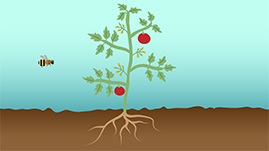Teachers' Domain - Digital Media for the Classroom and Professional Development
User: Preview



Understanding plant structure is important to human survival. Plants can live without humans, but humans cannot live without plants. In other words, plants are producers in the food chain, and humans are consumers. Over time, humans have used their understanding of plant systems to develop many ways to cultivate plants for food.
Plants have two major structural systems: the root system and the shoot system. Each of these structural systems has specific roles in the function and health of the plant. The root system brings in water and nutrients from the soil, grounding the plant in the same way our feet help us balance. The shoot system transports water and nutrients to leaves and flowers. The leaves of the plant are the main location for photosynthesis. Plant reproduction occurs through pollination of the flower and fertilization.
An analysis of plant structure leads to many questions: How do plants and animals differ? What parts of plants do we eat? Why do plants continue to grow throughout their lives? How do they make their own food? How do plants reproduce? Are there male and female plants? What is the structure of plant cells? How are they similar to and different from the cells in human and animal bodies? All these questions can be the basis for rich experiential learning in the classroom and outdoors.
 Loading Standards
Loading Standards